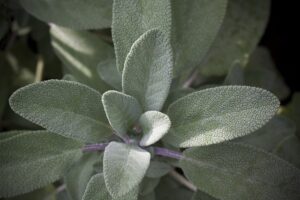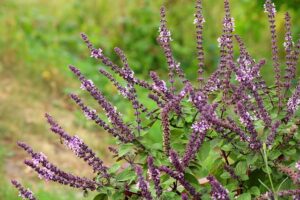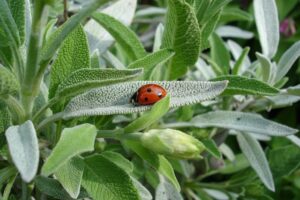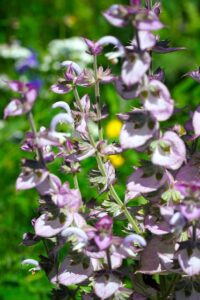How to Grow Sage

|
SAGE |
|
|
ZONE |
4-8 |
|
SUNLIGHT |
Full Sun |
|
WATER |
Water if top two inches of soil is dry. Do not over water |
|
Ph |
6-7 |
|
height/width |
4 foot tall and wide |
|
soil requirements |
Well-draining, sandy, gravel in soil is fine |
|
flowering/fruiting |
Late spring purple to blue flowers |
|
spacing |
Space plants 2 feet apart |
|
when to plant |
Early Spring |
|
How to plant |
Plant seeds 1/4 to 1/2 inches deep |
|
when to harvest |
Right before flowering |
|
pruning needs |
Can cut back up to 1/3 of plant |
|
Cultivars |
Garden Sage (Salvia officinalis). Purple Sage (Salvia officinalis ‘Purpurascens’):. Golden Sage (Salvia officinalis ‘Icterina’) Clary Sage (Salvia sclarea) |
Sage, or Salvia officinalis, is a perennial herb that belongs to the mint family. It is native to the Mediterranean and is esteemed for its culinary, medicinal, and ornamental uses. As a widely used herb in cooking, sage imparts a warm, aromatic flavor to a variety of dishes. Moreover, sage has been valued in traditional medicine for its anti-inflammatory, antiseptic, and antioxidant properties. Its subtle green leaves are also a popular choice in landscape design due to their aesthetic appeal. Learn how to grow sage so you will never be without this herb.
Sage Growing Needs
Sage, a perennial, evergreen subshrub, thrives best in a Mediterranean climate and can be cultivated successfully in USDA zones 4-8. It prefers full sun, although it can tolerate a bit of shade. A well-draining soil, particularly one that’s sandy or gravely, is ideal for sage herb’s growth. The soil pH should be on the alkaline side, anywhere from 6.0 to 7.0. Sage does not require excessive watering and can be susceptible to root rot if overwatered. A moderate watering schedule is sufficient, allowing the soil to dry out somewhat between each watering.
Sage Watering Schedule
A moderate watering schedule for sage herb typically involves watering the plant once every week to ten days, although this may vary depending on local climate conditions. Water the plant deeply but infrequently, ensuring the soil is thoroughly moistened each time. However, it’s important to let the soil dry out almost completely between waterings, as sage is very sensitive to excessive moisture. In hotter, drier climates, more frequent watering may be needed. Conversely, in cooler, wetter climates, you may need to water less frequently. Always check the soil before watering. If the top 1-2 inches of soil are dry, it’s time to water your sage plant again.
Sage plants generally don’t require a lot of water. They can tolerate fairly dry conditions. Maintain a consistent watering schedule to keep the soil moderately moist. However, exercise caution to avoid overwatering, as excessive moisture can result in root rot. Allow the soil to partially dry out between each watering session. This approach ensures optimal word choice, structure, readability, and eloquence while preserving the original meaning.

Fertilizing Sage
When it comes to fertilizing, sage isn’t a needy plant. An application of a balanced, slow-release fertilizer in spring should do the job for the entire growing season. However, make sure the soil isn’t too rich; sage tends to produce more flavorful leaves when grown in slightly impoverished
Planting Sage
When deciding to plant sage, you can opt for either seeds or cuttings. Sage seeds are readily available at gardening stores and online. On the other hand, if you choose to go for cuttings, find a mature sage plant, and snip off a small part, ensuring that it has a few leaves attached.
Before planting, prepare the area properly. Sage prefers well-draining soil with a pH range between 6.0 and 7.0. The chosen spot should receive ample sunlight, as sage needs full sun exposure for at least six hours a day.
Plant seeds or cuttings in the spring, after the last frost date. If planting in pots, choose a container with good drainage holes and fill it with potting mix. Place the seeds or cuttings in the soil, cover lightly, and keep moist until germination occurs.
Planting Depth for Sage Seeds and Nursery Plants
When planting sage seeds, they should only be lightly covered with soil, around 1/4 to 1/2 inch deep. They need some light to germinate and burying them too deep can inhibit this process.
As for sage nursery plants or cuttings, they should be planted at the same depth they were growing in their previous pot. Generally, this is about 2-3 inches deep depending on the size of the plant. Ensure the top level of the soil is just covering the roots and not touching the stem or leaves.
When to Plant Sage
The ideal time to plant sage is in late spring or early summer when the soil has warmed up from the winter chill. Although sage can tolerate light frost, it is advisable to plant it after the last expected frost date to ensure the plant gets a healthy start. For seeds, sowing them indoors 6-8 weeks before the last spring frost date allows them to germinate in optimal conditions. Transplant the seedlings or plant the cuttings outdoors when the average daily temperature consistently stays above 50°F (10°C). Remember, sage thrives in full sun, hence, select a sunny spot in your garden to ensure your sage plant grows well.
Sage Plant Size
Sage plants grow quite large, often reaching up to four feet in height and width. So, ensure you provide enough space between plants to prevent overcrowding. With adequate care and optimal conditions, your sage will be ready to use in your kitchen or for its decorative appeal in no time.## Caring for the Sage Plant
Sage is a perennial plant. This means it can live for more than two years, going through cycles of growth and dormancy depending on the season. In the right conditions, a sage plant can continue to thrive for several years, producing an abundant supply of leaves for culinary or ornamental use. However, it is important to note that after a few years, the plant may become woody and less productive. At this stage, it might be beneficial to replace the plant with a new one to ensure consistent yield.

Pruning and Maintenance
As for pruning and maintenance, regular pruning will help keep your sage plant robust and healthy. Prune sage plants in the early spring to encourage growth of new shoots. Trim off about one-third of the plant, cutting just above the point where two leaves meet. This encourages the plant to branch out and get bushier. Keep on top of removing any dead or diseased leaves to ensure your plant stays healthy and looks its best.
Harvesting and Storing
Harvesting sage is straightforward. The best time to harvest is just before the plant blooms, usually in the late spring or early summer, as this is when the flavors are at their peak. Using a sharp pair of garden shears, cut just above the node where two leaves meet, taking care not to remove more than one-third of the plant at a time.
Both sage leaves and flowers can be used, but they have different applications. The leaves of the sage plant are commonly used in cooking due to their strong aroma and robust flavor. They can be used fresh or dried, and they’re especially popular in dishes like stuffing, sausage, and poultry. On the other hand, sage flowers, while not as commonly used as the leaves, are also edible. They can be used to garnish dishes, adding a subtle sage flavor and a pop of color. They can also be used in salads or as a unique ingredient in homemade syrups and teas.
After harvesting, there are two primary methods for drying sage. The first method is air drying. To do this, bundle several stems together, secure them with a string, and hang them upside down in a warm, dry, and dark place for about two weeks. The second method is oven drying. Simply spread the leaves out on a baking sheet and dry them in a very low-heat oven (no hotter than 180°F) for 2-4 hours, making sure to turn them occasionally. You can also use a dehydrator if you have one.
Once your sage is fully dried, store it in an airtight container in a cool, dark place. Properly stored dried sage can last up to six months to a year. Another option for storing fresh sage is to freeze it. To do this, rinse the leaves and pat them dry before placing them in an airtight freezer bag or container. Frozen sage can last up to six months, but it may lose some of its flavor and aroma in the process.
Propagation
Sage propagation can be achieved through seed sowing, cuttings, or division.
To propagate by seed, plant the seeds in a well-draining soil mix in early spring. Cover lightly with soil, and water thoroughly, and keep warm until germination occurs, usually within 2 weeks.
Propagating sage through cuttings is another popular method. In the late spring or early summer, take a 4-6 inch cutting from a healthy sage plant. Remove the lower leaves, dip the cut end in rooting hormone, and plant it in a pot filled with well-draining soil mix. Water regularly and keep in a warm location until new growth appears.
Lastly, sage can be propagated through division in the early spring or fall. This involves splitting an older, established plant into several smaller plants. Each new plant should have a healthy root system and at least a few leaves. After division, replant each new sage plant in well-draining soil and water thoroughly.
Regardless of the method you choose, patience is key. With the right care, your propagated sage plants will thrive and provide you with a plentiful supply of this aromatic herb.
Common Problems and Solutions
Sage plants can be targeted by several common pests and diseases.
- Aphids: These small, sap-sucking insects can cause the leaves to curl and yellow. An effective treatment is spraying with a mild solution of soapy water, or using neem oil. Regularly inspecting plants and dealing with infestations early can prevent their spread.
- Powdery Mildew: This fungus appears as a white, powdery coating on the leaves. Improve air circulation around the plant, avoid overhead watering, and use a fungicide if necessary.
- Downy Mildew: Downy Mildew will cause yellow spots on the tops of the leaves and a white, downy growth on the underside. It thrives in damp conditions, so ensure your sage has well-draining soil and water it at the base to keep the leaves dry.
- Root Rot: If the roots of your sage are constantly wet, they may rot, causing the plant to wilt and discolor. To prevent this, ensure sage is planted in well-draining soil and be careful not to overwater.
To prevent these issues, ensure your sage plant has plenty of sunlight, is not overcrowded, and has well-drained soil. Regularly inspecting your plants for early signs of disease will also help keep them healthy.
Cultivars of Sage
There are several cultivars of sage that exhibit a variety of characteristics, making them suitable for different uses and preferences.
- Garden Sage (Salvia officinalis): The most common type of sage used for cooking, it’s characterized by its grey-green leaves.
- Purple Sage (Salvia officinalis ‘Purpurascens’): This variety has attractive, purple-tinged foliage and the same aromatic properties as garden sage.
- Golden Sage (Salvia officinalis ‘Icterina’): This cultivar features variegated leaves of gold and green and is a popular choice for adding color to the garden.
- Pineapple Sage (Salvia elegans): Named for its pineapple-scented leaves, this variety is often used in desserts or as an ornamental plant.
- Clary Sage (Salvia sclarea): This variety is grown for its essential oil, which is used in perfumery and aromatherapy.

Each of these cultivars brings something unique to the table, whether it’s a fragrance, a flavor, or an aesthetic appeal.
Conclusion
In conclusion, growing sage can be an extremely rewarding endeavor. Not only does this hardy herb offer aesthetic value with its silvery leaves and appealing texture, but it also provides a bountiful supply of fragrant leaves for culinary use. Always remember that the key to successful sage cultivation lies in understanding and providing for its basic needs: well-draining soil, ample sunlight, and controlled watering. With the right care, your sage plant can thrive and continue to produce for many years. Additionally, don’t be disheartened by common pest or disease issues. By regularly inspecting your plant, taking preventative actions, and addressing problems early, you can maintain the health and productivity of your sage. Happy gardening!
For more on growing herbs click here
For info on the benefits of sage click here.
